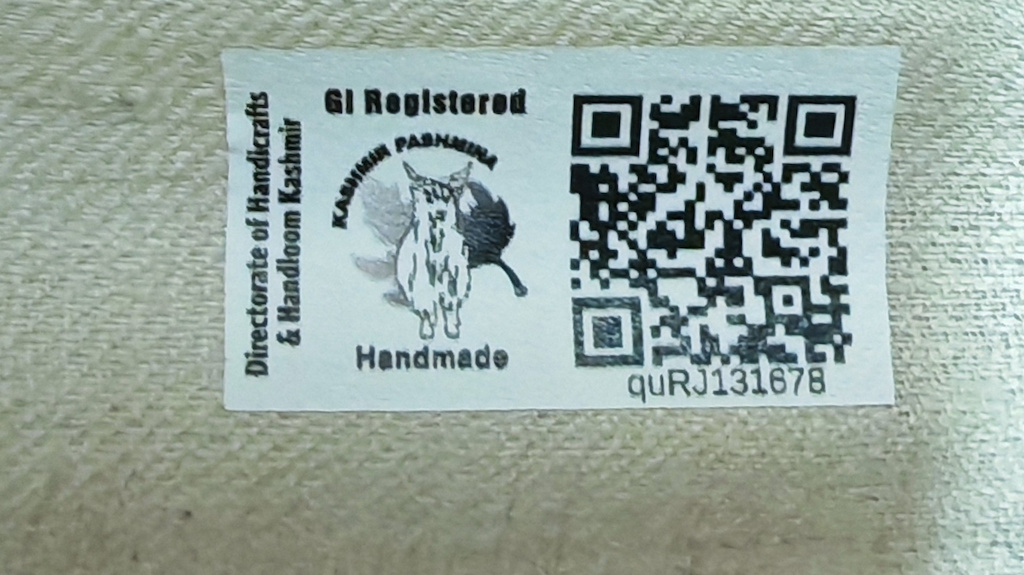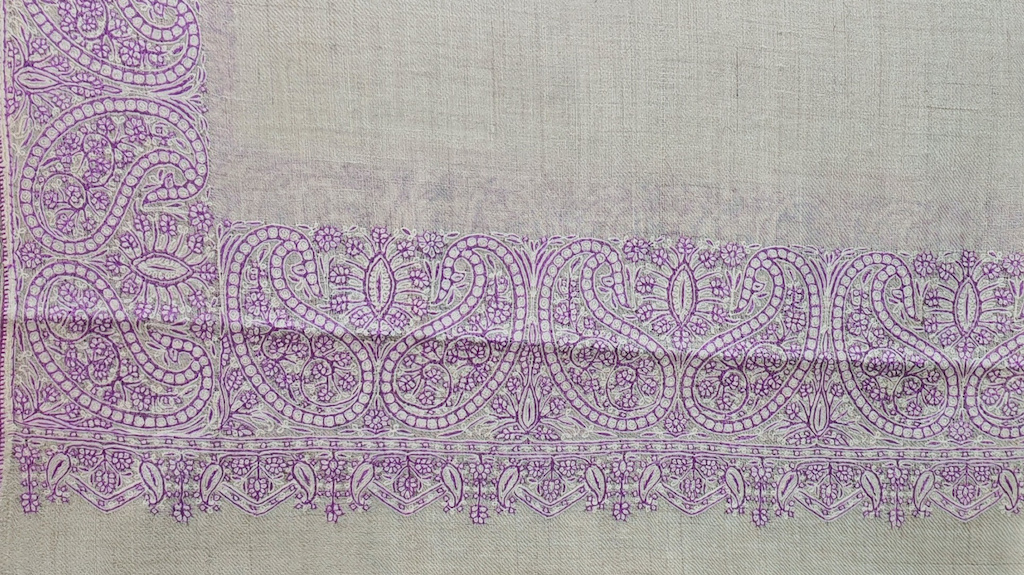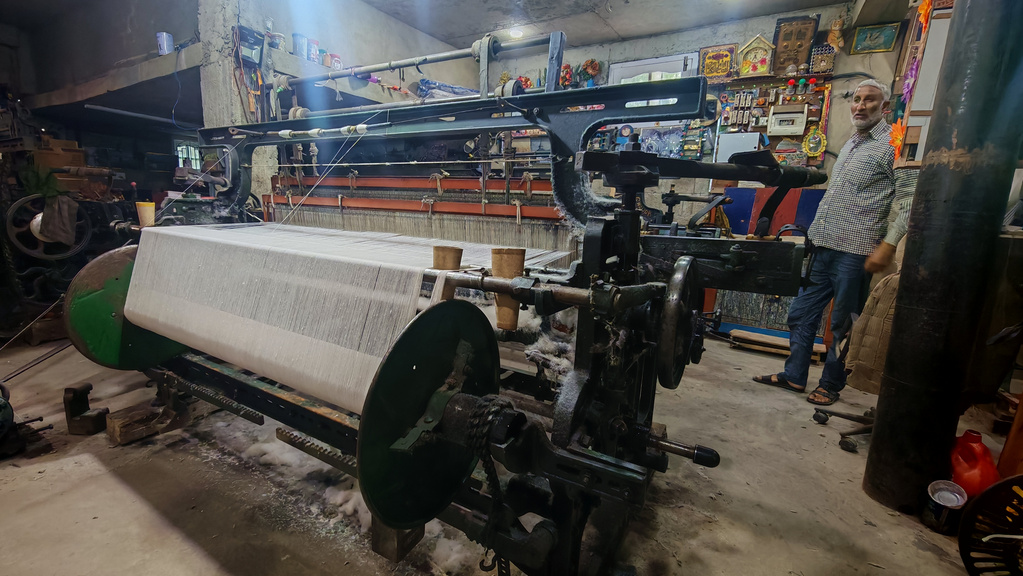
Fiba Arif and Irfan Ahmad argue that introducing mechanical looms is important to keeping the tradition of pashmina shawls accessible and alive.
(A message to the reader.)
Pashmina shawls have been draping the shoulders of royalty and fashionistas alike for centuries. Originating from the fine undercoat of the Changthangi goat (Capra aegagrus hircus) of Ladakh, India, these luxurious shawls are a testament to Kashmir’s artisanal heritage, manifesting the subtle balance between nature and craftsmanship. The artistry of weaving pashmina by hand is not merely a process of creating a product but of keeping alive a legacy handed down through generations. The name “pashmina” itself conjures a vision of elegance and sophistication, a cloth which has been highly prized since at least 3000 B.C. Even within the epic accounts of the Mahabharata, pashmina was the cloth of the privileged, securing its well-deserved place as the “fibre for Kings“. This heritage stands today not just in thread and wool, but in the memory of 28 artisans draped in white shrouds of crimson red during “Zaldagar agitation” of April 29, 1865, in Srinagar, Kashmir, against the tyrant Dogras.
The “Zaldagar agitation” is considered a significant event in the history of Kashmir and South Asia. It was a protest by Shawlbafs (Kashmiri shawl weavers) against high taxes and exploitative working conditions levied by the Dogra rulers. The protest, which began peacefully, resulted in a brutal crackdown by the Dogra army, leading to the deaths of 28 weavers and injuries to many others. This event is often seen as a pivotal moment in Kashmir’s resistance against oppression and is considered the first indigenous political movement of modern South Asia. Hence, it would be a disservice to the truth and to the memory of those who suffered to delve into the article without first recognising the profound sacrifices made by the Kashmiri shawl weavers.
Origin of Pashmina
The art of weaving pashmina shawls has a rich history in Kashmir, although the exact origins remain shrouded in mystery. Some historians trace the craft back thousands of years, while others suggest a more recent inception. While Zain-ul-Abidin institutionalised and expanded Pashmina weaving in the fifteenth century, it was Syed Mir Ali Hamdani in the 14th century who first introduced the craft and the concept to Kashmir, making him the pioneer of Pashmina weaving in the region. The artisans from Persia and Central Asia not only brought weaving techniques but also taught local Kashmiris to spin and weave this delicate wool into luxurious shawls. This laid the foundation of the Pashmina craft tradition in the region, turning it into a culturally rich and economically significant activity.
This exquisite material is derived from the undercoat of a special breed of goats that thrive in the harsh climates of high-altitude regions, particularly in Tibet, Mongolia, and India. These resilient goats develop a fine, downy undercoat to withstand the biting cold of winter, resulting in the creation of pashmina. In India, the Changthang region of Ladakh is the primary source of this coveted fibre. Nestled at elevations between 4,000 and 4,500 meters, this high-altitude cold desert is home to the Changpa nomads, who have perfected the art of pashmina collection. During the summer months, when the goats no longer require their thick winter coats, the Changpas gently comb the goats to gather the precious pashmina. This raw material, a blend of fine pashmina and coarser goat hair, undergoes a meticulous transformation before it can be woven into the stunning shawls and stoles that are so highly sought after.
The process of making Pashmina
The journey of pashmina from goat to garment is a fascinating process. Initially, the raw fibre is cleaned and separated from the coarser hair through a method known as de-hairing. While this task was once performed by skilled artisans, modern technology has introduced machines that streamline the process. Once cleaned, the pashmina is carded and spun into fine yarn. Historically, this spinning was a labour of love done by hand, but today, many artisans utilise spinning mills to enhance production and to meet the demand. The yarn is then dyed in a spectrum of colours, ready to be woven into beautiful pashmina products.
Kani Pashmina shawls are woven using a unique twill-tapestry technique that involves several intricate steps. The process begins with the Naqash, or pattern drawer, who meticulously creates a design on graph paper. This design is then translated into a coded script by the TalimGuru, guiding the weavers on how to interlace the threads. The warp is prepared by a skilled artisan known as nakatu, and the loom is dressed by the pennakamgur. Finally, the shawl is woven from right to left, resulting in a stunning piece of art.
Not so long ago, skilled artisans would spend months weaving these delicate pieces, transforming mere fibres into works of art that could make even the most stoic of hearts swoon. Fast forward to today, and we find ourselves in a world where machines are promising to “give new life to ancestral techniques”. These machines can churn out shawls faster than one can utter “pashmina.” However, the irony is palpable. As we embrace technology, we risk losing the very essence of what makes pashmina special: the human touch. The whir of machinery lacks the soulful serenade of a weaver’s hands. Still, in an era where sustainability is the buzzword du jour, machine-assisted pashmina production emerges as a game-changer, giving artisans a superhero cape by reducing strain, increasing output, and allowing for scalability that hand-weaving simply can’t match.

The numbers are as compelling as a well-stitched seam. Industry data reveals that machine weaving can slice production time by a staggering 50%, all while preserving the luxurious texture that has made pashmina synonymous with elegance. A 2022 study found that a whopping 78% of pashmina producers in Kashmir reported a 30% increase in output after welcoming machinery into their workshops, without sacrificing quality.
In a world where luxury often feels out of reach, the advent of mechanisation in pashmina production has opened new doors, allowing this exquisite fabric to be accessible to a broader audience. Once the exclusive domain of the wealthy, pashmina shawls are now within the grasp of many. Credit goes to the innovative technologies that have revolutionised the production process.
Perspectives of industrialists
In the quiet workshops nestled in the heart of Kashmir, one can almost feel the stories unfolding as artisans gently coax the delicate pashmina threads on their looms, sunlight illuminating the intricate designs blossoming beneath their knowing hands – a legacy passed down through generations. To understand how this timeless artistry meets the currents of a changing world and explore more about the advent of mechanisation in this sector, and its impacts, we engaged in conversation with two pashmina business owners who support the fusion of tradition and innovation in pashmina production, albeit in distinct ways.
Our first interviewee, Mr. Peer Zaid, an industrialist in his early thirties with a postgraduate degree, has a profound appreciation for the craft. He runs a workshop that produces machine-made pashmina and wool articles. The walls of his workshop are adorned with exquisite shawls. While discussing the difference between machine-made and handwoven pashmina shawls, he stated,
“While the cost of machine-made shawls is significantly lower than that of handwoven ones, the quality gap is narrowing when good quality machine work is employed”.
However, he was quick to clarify that mechanisation has not replaced handwork. “Handwork simply cannot meet the soaring demand driven by materialism,” he noted, acknowledging the pressures that modern consumerism places on traditional artisans. The reality is that the exquisite craftsmanship of handwoven pashmina, while unparalleled, cannot keep pace with the increasing global demand. This is where mechanisation steps in—not as a rival, but as a collaborator.
The owner also shared the challenges faced by handwork artisans, who often find themselves ensnared in a web of long credit periods and exorbitant commissions taken by middlemen. Spinning Pashmina and Shahtoosh using a traditional spinning wheel called “Yinder” was once a household affair in Kashmir, primarily the domain of young girls and women, and in the 1990s there were tens of thousands of women involved in the process across Kashmir, “Now many artisans are leaving the industry because the returns on their handwork are simply not sustainable,” he lamented.
In contrast, his firm, which exports 90% of its production, has embraced mechanisation as a solution. “It’s not about replacing handwork; it’s about enhancing it,” he emphasised. By integrating technology into the production process, artisans can produce more without sacrificing quality. “Machine work doesn’t start where handwork ends; it complements it,” he asserted, reinforcing the idea that both methods can thrive together. His workshop utilises a combination of machinery run by skilled persons, utilising the computer software for delicate and fine embroidery, cloning the handwork with great accuracy. As we delved deeper into the conversation, it became clear that the advent of mechanisation has democratized luxury, making it affordable to a broader audience, which has enhanced the market of this workshop manifold.

Mr. M. A. Kumar (Pashmina Handloom Owner) showing hand-woven pashmina, “Handwoven Pashmina”, 2025, Pashmina Shawl, 2268×4032×24, photo: Irfan Ahmad
In contrast, our second interviewee, a passionate artisan, Mr. Mohammad Amin Kumar, working in this sector for 35 years, shared his philosophy on the delicate balance between tradition and modernity in pashmina production. While he utilises machines for the initial spinning of the yarn, he firmly believes that the heart of pashmina lies in the handwork that follows. “Hand embroidery is what defines pashmina,” he said, resonating deeply with his clientele, particularly the elite class who appreciate the artistry and uniqueness of handwoven pieces.
The departure of artisans from the spinning industry created a significant gap that catalysed the adoption of spinning machines. The yarn spinning artisans are typically confined to rural areas. As a result, their numbers are significantly decreasing. This is also because their earning is too low. He quoted that a spinning artisan, who spends about 3 months engaging in the work for 4-5 hours per day, earns only around 2000-3000 rupees (or approximately $USD 24 per month) for that work.
Hand spinning contributes around 10% and machine spinning about 90% to the production on his loom. He emphasised that the sales have increased since he introduced yarn spinning machines in his loom. This is because the fast spinning by machine increased production manifold, reduced over-dependence on spinning artisans, and ensured mass production and uniformity in the articles.
However, the machine is confined to spinning only, followed by hand weaving and hand embroidery. The owner shared that his major buyers actively seek out these handcrafted items, often willing to pay a premium for the authenticity and artistry that comes with them. Interestingly, the returns on these hand-embroidered shawls are significantly higher, with a profit margin that reflects the value of the labour and love poured into each piece. With 80% of his sales are localised and the rest international. He is currently happy with the returns.
Hand skills in machine weaving
Machines undoubtedly handle the bulk of the production in pashmina products, such as shawls, stoles, and mufflers, significantly increasing output beyond what hand skills alone could achieve. However, the involvement of artisans, though not extensive in the weaving itself, remains crucial for various stages beyond just weaving. While the mechanical loom handles the rapid production of the fabric, the delicate nature of pashmina wool, even when blended with other fibres (wool, synthetic) to withstand machine stress, still requires specialised hand-finishing.
Artisans are typically involved in preparing the raw pashmina fibres, including meticulous cleaning and sorting to ensure only the finest hairs are used.
Artisans are typically involved in preparing the raw pashmina fibres, including meticulous cleaning and sorting to ensure only the finest hairs are used. After machine weaving, the fabric often undergoes crucial “purz-gari” – a painstaking process where artisans meticulously tweeze, clip, and brush the shawl to remove any loose threads, knots, or imperfections left by the machine. This “purz-gari” is essential for achieving the smooth, refined surface and luxurious feel that pashmina is known for. Furthermore, dyeing the machine-woven pashmina may also be a hand-done process. Skilled dyers use traditional methods and natural pigments to achieve vibrant and even colours, a process that requires a keen eye and extensive experience to ensure consistency and prevent damage to the delicate fibres.
Moreover, even within these mechanised setups, the physical movement of the pashmina at different stages relies on human labour. Workers are consistently involved in transporting the delicate raw pashmina fibres from storage to initial cleaning sections, then moving the processed yarn to the power looms, and finally, shifting the woven fabric to the finishing, dyeing, and inspection areas. Such tasks are predominantly performed by manual labour. In essence, machines enhance production capacity, allowing for broader access to pashmina. At the same time, the involvement of human skill and labour ensures that the essence of quality and craftsmanship is maintained, besides securing livelihoods rather than diminishing them.
How to find authentic pashmina
ku
With the market flooded with imitations, ensuring you’re getting an authentic Pashmina shawl requires a discerning eye. True Pashmina, known for its luxurious softness and warmth, is a significant investment, so knowing how to spot the real deal is crucial. The following are reliable methods to help you distinguish genuine Pashmina from counterfeits:
Check for the GI (Geographical Indication) label

For assurance, look for a GI Certified label. This certification guarantees that the Pashmina has been authentically sourced and meticulously crafted in Kashmir, the traditional home of these exquisite shawls.
Inspect the weave
If you want exclusive hand-loomed Pashmina shawls, their weave will show slight irregularities. Look closely; a perfectly uniform pattern often indicates a machine-made shawl.
The ring test
Genuine Pashmina yarn is incredibly fine. A classic test involves gently pulling the shawl through a small ring. A pure Pashmina shawl, due to its exceptional fineness, should pass through with ease. If it snags or doesn’t pass through, it’s likely not pure. Machine-made Pashmina cannot be differentiated by this method, and this method also has a limitation, as mechanised products mimic authentic pashmina, often mixed with wool and other synthetic products, are woven and softened to a level that can pass the ring test.
The burn test
Authentic Pashmina is made from natural fibres. When a small thread is burned, it should produce a smell similar to burning hair and turn into a powdery ash. Counterfeit shawls, often made from synthetic materials, will smell like burning plastic and likely melt into a rigid bead.
Feel the texture
The defining characteristic of real Pashmina is its incredible softness. It should feel plush and smooth against your skin, never scratchy or coarse. This feel can be discerned by experienced hands.
Microscopy and fibre test
The test is done at certified Pashmina centres, where microscopically the fibre is tested.

In conclusion, the journey of pashmina shawls from handwoven masterpieces to machine-assisted creations reflects a broader narrative of adaptation and resilience. Machinery is not the villain in the age-old battle between tradition and modernity. Instead, it’s more of a sidekick, ready to assist rather than overshadow. While the essence of these shawls remains rooted in tradition, the infusion of mechanisation has the potential to elevate the sector. By embracing technology, we are allowing the stories woven into each shawl to reach new hearts and homes. We honour the craftsmanship of the artisans while also welcoming the innovations that can breathe new life into this cherished art form. By this means, the legacy of pashmina will continue to flourish for the generations to come, bridging the gap between the old and the new, and the timeless beauty of this remarkable textile will remain preserved!
About Fiba Arif and Irfan Ahmad
 Ms Fiba Arif, a graduate student at the Faculty of Fisheries, SKUAST- Kashmir, has a deep passion for writing. I believe in the power of language and its ability to connect, inform and inspire. I enjoy writing fiction that captures thoughts and imagination in words, using ideas that connect people and tell the story of deaf-mutes.
Ms Fiba Arif, a graduate student at the Faculty of Fisheries, SKUAST- Kashmir, has a deep passion for writing. I believe in the power of language and its ability to connect, inform and inspire. I enjoy writing fiction that captures thoughts and imagination in words, using ideas that connect people and tell the story of deaf-mutes.
 Dr Irfan Ahmad is a professor at the Faculty of Fisheries, SKUAST-Kashmir, India. I hail from the breathtaking valley of Kashmir, a land rich in beauty and culture. As a passionate photographer, I strive to capture and preserve the authentic essence of Kashmiri life. It was in our minds that we would write for the Pashmina fabric industry in two dimensions, handwork and machine work. The subsequent write-up will be about “from luxurious shawls to modern fashion — tracing the versatility of Pashmina, while examining the ethical and legal backdrop that led to Shahtoosh – King of wools being outlawed.”
Dr Irfan Ahmad is a professor at the Faculty of Fisheries, SKUAST-Kashmir, India. I hail from the breathtaking valley of Kashmir, a land rich in beauty and culture. As a passionate photographer, I strive to capture and preserve the authentic essence of Kashmiri life. It was in our minds that we would write for the Pashmina fabric industry in two dimensions, handwork and machine work. The subsequent write-up will be about “from luxurious shawls to modern fashion — tracing the versatility of Pashmina, while examining the ethical and legal backdrop that led to Shahtoosh – King of wools being outlawed.”


